Scottish Shelf Model. Part 6: Wider Domain and Sub-Domains Integration
Part 6 of the hydrodynamic model developed for Scottish waters.
Introduction
This report provides the methodology used to calculate connectivity indices between Scottish aquaculture Farm Management Areas, using 3D currents from climatology-forced output of the Scottish Shelf Model and the FVCOM offline particle tracking model.
- Calculation of Connectivity Indices among Aquaculture Management Areas in Scotland
Within the Scottish Shelf Model project there is a requirement to deliver "Connectivity indices (which may be defined as the degree of dynamic interactions between geographically separated populations via the movement of individuals), such as transition probability matrices between (finfish aquaculture) Farm Management Areas ( FMA)." Further background has been provided in a note prepared by Alejandro Gallego ( AG) of Marine Scotland, including the statement that "If the spatial scale of specific FMAs is not adequate ( e.g. too small or too large) for a tractable analysis, connectivity indices may be produced for alternative oceanographically-coherent areas." Some decisions about this have been made, in order to proceed, as discussed below. The note also provided relevant biological and aquaculture management information and information on appropriate connectivity timescales, which is summarised here.
The aim is the computation of connectivity indices in the form of transition probability matrices identifying the proportion (and number) of Lagrangian particles released from each individual ("source") FMA which reach any other ("target") FMA (including self-recruitment). This was to be carried out by tracking artificial (neutrally buoyant) particles introduced into the Scottish Waters model, with embedded high-resolution sub-areas. These particles represent individual organisms or groups of organisms which are advected and dispersed by the flow. It was proposed that the relevant Lagrangian simulations to be carried out fulfil the following characteristics:
- The simulations are to be carried out off-line from the FVCOM hydrodynamic model runs, using the FVCOM particle tracking software.
- The simulations are to be carried using a combined mesh in which the sub-domain models will be merged into the Scottish Shelf Waters ( SSW) model so that the highest available resolution will be used in all areas. If the resolution is still not sufficient for aquaculture management, there is a need to agree with MSS the provision of connectivity matrices between oceanographically-coherent areas, as mentioned above.
- The simulations are to be carried out using the climatology output of the hydrodynamic model and sub-models. The basic time step is to be one hour, which is the output time-step of the Climatology run. There is a sub-time-step within the particle model, typically a few minutes, to interpolate the flow to provide a reasonable trajectory within each advection time step e.g. not crossing land. There is a further sub-division of the time step for the random walk component of the trajectory, representing sub-grid-scale diffusion.
- Given the year-round prevalence of diseases and parasites and the likely seasonal oceanographic variability, these simulations should ideally be carried out for 4 seasons ( e.g. using a single mid-season starting point).
- Particles are to be released from "wet" (water depth > 0 m) points covering the entirety of each FMA.
- The number of particles per start position and their horizontal (and, where relevant, vertical) spacing are to be sufficient to achieve numerical stability, accounting for stochastic processes (diffusion).
Three types of biological organism are to be considered as follows:
- Sea-lice larvae - representative species Lepeophtheirus Salmonis (Leps): these will be modelled as particles with a fixed position in the vertical (3m constant depth) with passive horizontal drift (including horizontal diffusion). The pelagic larval duration ( PLD) is temperature-dependent so, based on some generalisations, this could be approximated to 18 days (winter), 15 days (spring and autumn) or 10 days (summer), comprising a 5-day non-infectious period + 10-day infectious period (spring and autumn), or the approximate pro-rata equivalent for the remaining seasons. All "target" FMAs reached within the infectious part of the PLD will be scored.
- Infectious Salmon Anaemia Virus ( ISAV - representative short-persistence pathogen): Whole water column releases and passive vertical and horizontal drift (including diffusion) will be used. Pelagic duration = 3 days. All "target" FMAs reached within this period are to be scored.
- Infectious Pancreatic Necrosis Virus ( IPNV; representative long-persistence pathogen): Whole water column releases and passive vertical and horizontal drift (including diffusion). Pelagic duration = 35 days (autumn to spring) and 17 days (summer), respectively. All "target" FMAs reached within this duration are to be scored.
A first draft of this methodology report was reviewed by Prof Christina Sommerville ( CS, Institute of Aquaculture, University of Stirling) in March 2014. Her response focussed on the sea lice life cycle and behaviour (her area of expertise) rather than particle tracking modelling and connectivity. Details of the implemented methodology are described in section 3 below, after being fully discussed and agreed with Marine Scotland ( AG) prior to carrying out the simulations. The following section provides some definitions and references to recent work on hydrodynamic modelling, dispersion, particle tracking and sea lice dispersal in particular.
- Background
Population connectivity is often used to explore the viability of populations recruiting individuals from neighbouring habitats of varying separation distance ( e.g. Phelps et al., 2014; Phelps, 2015). However here we are looking at another aspect - the likelihood of parasites and disease spreading to adjacent populations of farmed salmon in Scottish Waters. We look at two issues: dispersal of sea lice larvae and dispersal of viruses. For sea lice, connectivity depends on pelagic larval duration ( PLD) as well as other factors, such as the survival and behaviour of larvae, and the fecundity of adults. Gallego et al. (2013) state that the mean transport distance was mostly related to the duration of the pelagic larval phase, although season of spawning and distance to shore were also important factors. The mean straight distance between start and end positions at the end of the PLD can only give an approximation of the actual transport. The actual particle trajectories will always be longer due to tidal and random (diffusion) effects, in addition to the circulation around land masses.
Definitions:
Connectivity, in marine ecology, is the exchange of individuals among marine populations (Cowen and Sponaugle, 2009). Connectivity can refer to the flux of any material ( e.g., organisms, gametes, genes, disease vectors, nutrients) between locations. In their paper they focus explicitly on the movement of individuals within and among local or subpopulations, assuming that the level of exchange, when referring to population connectivity, must be sufficient to impact the demographic rates of the local population(s).
A Connectivity matrix (Cowen and Sponaugle, 2009) provides the probability of exchange of individuals between patches; if the matrix is normalized with respect to the number of individuals in population i, then the matrix element P ij gives the probability that an individual in population i came from population j. We wish to calculate the relative connectivity between origin and destination FMAs, based on the percentage of all particles released at each origin FMA (Gallego et al., 2013).
Larval dispersal is the intergenerational spread of larvae away from a source to the destination or settlement site by the end of the larval stage.
Pelagic Larval Duration is the time that larvae can persist in the water column
Larval Behaviour
Many larvae are able to regulate their position in the water column. This normally involves active vertical swimming to either maintain a desired depth throughout the planktonic phase or migrate vertically in response to physical and biological cues such as light intensity, tidal state or larval stage (Kingsford et al., 2002). Diurnal migration is common, moving vertically in the water column between night and day. Yet another relatively common vertical migration scheme is circatidal migration, which is characterised by swimming vertically in synchronisation with tidal state. For larvae aiming to reach inshore areas, this can allow them to avoid the ebbing tide (North et al, 2008; Adams et al., 2014b). Some larvae are able to exploit the vertical shear in tidal currents in order to manipulate their horizontal transport. This process is referred to as selective tidal stream transport (STST, Forward and Tankersley, 2001). It is not clear whether larvae that exhibit this type of migration respond to changes in pressure, salinity, turbulence or another physical cue (Kingsford et al., 2002).
Predation and mortality can also be important considerations. Not only does mortality reduce the overall number of larvae that survive through to adulthood, but if there are spatial variations to mortality, for example due to predator abundance, or food availability, then this can affect the overall spatial pattern of dispersal and connectivity.
Another common feature is the influence of physical properties, particularly temperature, upon larval growth. Typically warmer seawater temperatures lead to faster development, and therefore a shorter PLD and some larvae also develop at different rates according to seawater salinity. Shorter PLDs are typically associated with shorter dispersal distances. Other considerations include competition for resources, substrate availability and tolerances to physical properties such as temperature and salinity.
Larval swimming behaviour (even at small speeds) can influence dispersal and larvae may respond to physical cues such as a halocline (North et al., 2008) and migrate vertically. Horizontal swimming may also be relevant in some cases. Other elements of larval behaviour that have been successfully incorporated into numerical models include temperature-dependent larval development rates ( e.g. Phelps et al., 2014).
- Sea Lice
The sea louse (Lepeophtheirus salmonis) is a naturally occurring parasite on wild salmonids. Infestations of this sea louse pose a major economic burden to the Atlantic salmon aquaculture industry in Scotland and may be linked to the decline of wild salmonid populations (Amundrud and Murray, 2007) although this is still hotly debated. Fish farms can be areas of high concentration of sea lice and may represent infectious sources which provide a significant threat to wild stocks of migratory fish as they come into contact with the fish farm areas, although the source of the lice in any Farm Management Area ( FMA) is not exclusive to fish farms. Utilising a particle tracking model, we can study the movement of a 'modelled louse' between FMAs and the connectivity of these areas with respect to the transmission of infection.
Attempts at modelling to date have made suggestions as to the dispersal of larval lice over varying distances of up to 30km, 75 km and even 100km from source ( CS, pers. comm.). Other predictions suggest that the louse larvae could disperse an average of 27 km (range 11 to 45 km) over 5 to 15 days. Predicted averages for dispersal of sea lice larvae range from 12 km (range 5 -17 km) in low currents (~5 cm s -1 to 47 km (range 23 - 70 km) in higher currents (~ 20 cm s -1).
L. salmonis has three free-swimming planktonic larval stages: two (non-infective) nauplii and an infective copepodid (see Murray and Gillibrand, 2006, with further references therein). These non-feeding larval stages rely on yolk reserves to survive, and drift with the prevailing current until the copepodid encounters a host fish to attach to, whereupon it begins feeding and development progresses through a further 7 stages on the host (Fig. 1).

Figure 1: (a) Sea louse on host (b) Life cycle of Lepeoptheirus salmonis commonly called LEPS (from Marine Scotland Topic Sheet no 91 v1 Sea Lice: Control & Regulation)
They are not entirely passive, tending to keep in surface waters so that most infection occurs at depths of 0-4 m below the surface. Nauplii and copepodids are naturally buoyant owing to the lipid gut content. The copepodid hops upwards and then sinks downwards for longer, but the distance gained in upward swimming is greater than the distance sinking. e.g. a hop distance 1.43 cm; a sink 0.05cm. Swimming is halted at salinities 21-23 psu. They move up in the day and down at night e.g. from ~2m to 3.5m below the surface. Sea lice life cycles are entirely driven by temperature ( CS, pers. comm.). Based on laboratory experiments, the optimum temperature for L. salmonis is 10°C and optimum salinity is 33 to 35 psu. Prof Sommerville notes that environmental temperature will determine the rate of usage of the yolk and therefore the PLD (pelagic larval duration). This may be a more significant effect of temperature than its impact on developmental/maturation/growth rate of the larvae.
- Infectious Salmon Anaemia
Infectious salmon anaemia ( ISA) is a viral disease of Atlantic salmon ( Salmo salar L.) that can cause severe losses to infected farms, caused by the ISA virus ( ISAV). The disease was first reported in Norway in 1984, but has since been reported in Canada, the USA, the Faroe Islands, Ireland and Scotland. It causes severe anaemia of infected fish (unlike mammals, the red blood cells of fish have DNA, and can become infected with viruses). The fish develop pale gills and may swim close to the water surface, gulping for air. However, the disease can also develop without the fish showing any external signs of illness, the fish maintain a normal appetite, and then they suddenly d ie. The disease can progress slowly throughout an infected farm and, in the worst cases, death rates may approach 100%.
ISA appears to be most like influenza viruses. Its mode of transfer and the natural reservoirs of ISAV are not fully understood. Apart from Atlantic salmon, both sea-run Brown trout (Salmo trutta) and Rainbow trout ( Onchorhyncus mykiss) can be infected, but do not become sick, so it is thought possible that these species may act as important carriers and reservoirs of the virus
In May 1998, a salmon farm at Loch Nevis on the west coast of Scotland reported its suspicions of an outbreak of ISA. By the end of the year, the disease had spread to an additional fifteen farms not only on the Scottish mainland but also on Skye and Shetland. In 2008-9 there was another outbreak of ISA in Shetland. ISA was detected in fish from just one site, which was then harvested and left fallow. The disease was eradicated and no further outbreaks have occurred to date.
The virus can be transmitted through water, but the highest risk factors for spread of disease are movement of live fish, discharge of untreated blood and contact with infected vehicles and equipment. It is a notifiable disease in the EU and control measures are: compulsory slaughter and disinfection of infected farms, strict movement controls on suspect farms and placing farms in the vicinity of an outbreak under surveillance. ISA has a "weak" external protective capsid so it is unlikely to be viable any longer than 3 days in the water ( AG, pers. comm.).
- Infectious Pancreatic Necrosis
Infectious pancreatic necrosis ( IPN) is a severe viral disease of salmonid fish, caused by infectious pancreatic necrosis virus ( IPNV). This disease mainly affects young salmonids, such as trout or salmon, of less than six months, although adult fish may carry the virus without showing symptoms. Resistance to infection develops more rapidly in warmer water. It is highly contagious and found worldwide, but some regions have managed to eradicate or greatly reduce the incidence of disease. The disease is normally spread horizontally via infected water. Clinical disease is particularly important in farmed Atlantic salmon and Rainbow trout.
A sharp rise in mortality is often seen (depending on the virulence of the disease). Other clinical signs include abdominal swelling, anorexia, abnormal swimming, darkening of the skin, and trailing of the faeces from the vent. Surviving fish should recover within one to two weeks. Currently, no treatment is available.
Good husbandry measures, such as high water quality, low stocking density, and no mixing of batches, help to reduce disease incidence. To eradicate the disease, very strict protocol with regards to movement, water sources and stock replacement must be in place - this is difficult to achieve and very expensive. IPNV degrades with temperature, taking about 17 days to be inactivated at 15°C and 14 days at 20°C. A standard inactivation period of 35 days in autumn, winter and spring is assumed here ( AG, pers. comm.).
- Scottish Aquaculture Management
Marine fish farms typically consist of net pens that exchange
their contents easily with the environment. Released material
includes nutrients, organic waste, pathogens (including sea lice
and viruses) and medicines used to treat those pathogens. The
number of 'particles' released will vary according to season/water
temperature; age/size of fish and management practice
i.e. the number of particles released
at a fixed time point depends on:
a) The management practice
i.e. whether the management adhere to
treatment regulations which specify the number of allowable adult
females per fish before treatment.
b) Size/age of fish. Lice burdens will be heavier in larger
fish in year two of the production cycle than in year one fish,
unless no fallowing has been carried out, in which case smaller
year one stocked fish will also carry a heavy burden of lice.
The amount of dispersal of sea lice and their contribution to the decline in wild Atlantic salmon and sea trout has been debated over the years. A great deal of recent work has been carried out in Loch Torridon, on the west coast of Scotland. The biannual cycle of louse abundance along the shoreline at the head of Loch Shieldaig matched the production cycle of the local salmon farms, with the appearance of louse copepodids lagging behind farm louse burdens by 1 to 3 weeks (McKibben and Hay 2004). They found that the infectious stage could be located close to river mouths, using plankton sampling. Copepodids were present in high numbers over a sustained period and were abundant in the early spring at times when salmon and sea trout smolts go to sea. Such high levels of copepodids have not been recorded previously outside fish farm cages.
Although there are no FMAs on the east coast of Scotland, lice are present on the east coast with no apparent genetic differentiation from those on the west coast.
- Farm Management Areas ( FMAs)
These describe defined areas in which farmers undertake farming activities at one or more farm sites and plan and synchronise production in order to reduce and manage risks posed by infectious agents and parasites which can be present in the environment, in wild and farmed fish, and in other naturally occurring biota. FMA policies will, in some cases, focus mainly on stocking and production cycles, fallowing arrangements and sea lice management, while in others, they will relate to other issues which have a potential to affect fish health. N.B. not all designated SMAs will contain a fish farm.
A very simplified production cycle is as follows:
Fish are stocked in year one of the production cycle and grow on for up to 18 to 22 months. They may be stocked at different times depending on the age of the smolts. The fish are harvested in year two and a fallow period is used before the site is restocked. Only one year class at a time is stocked in any one site to avoid the heavier burdens found on year two fish infecting the newly stocked year one fish i.e. Single Year Class stocking, which is now universal in Scotland. The fallow period is varied but the Scottish Salmon Producers Code of Practice recommends a minimum of four weeks and an average of 21 weeks was recorded in 2013. It has many values but is also intended to empty the site of any mobile lice (larvae, pre adults and adults). It doesn't take into account any resident fish which may be infected e.g. sea trout, escaped fish or migrating salmon. However this procedure should ensure that sea lice infection should not spread to more distant FMAs by infecting intermediate locations, over several seasons.
- Disease Management Areas (DMAs)
These describe areas that are designated by Marine Scotland for the purpose of statutory controls for the management of fish diseases. They include areas defined in relation to the control of a range of listed diseases of fish. Notable examples are the control and surveillance zones, based on a tidal excursion model, established in relation to the management of ISA. FMAs may be smaller than, identical to, or larger than DMAs.
In Fig. 2, the Scottish Shelf Waters area is subdivided into several maps, which are shown in detail in Figs. 3 - 6, showing the individual FMA's, with a total of 87 management areas. We wish to know whether sea lice and viral dispersal can occur between these FMA's.
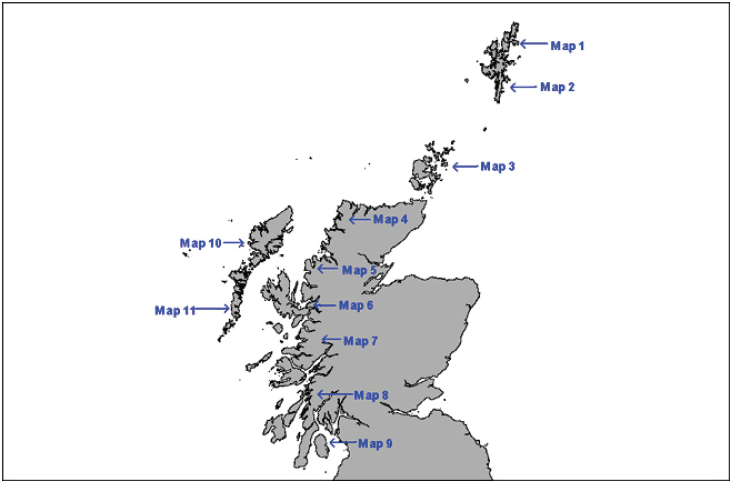
Figure 2: Map of locations of Scottish FMA group maps

Figure 3: Shetland (12 management areas)
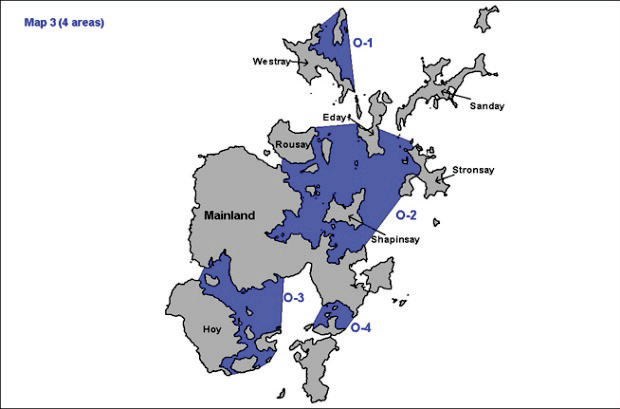
Figure 4: Orkney (4 management areas)

Figure 5: Western Isles (22 management areas)
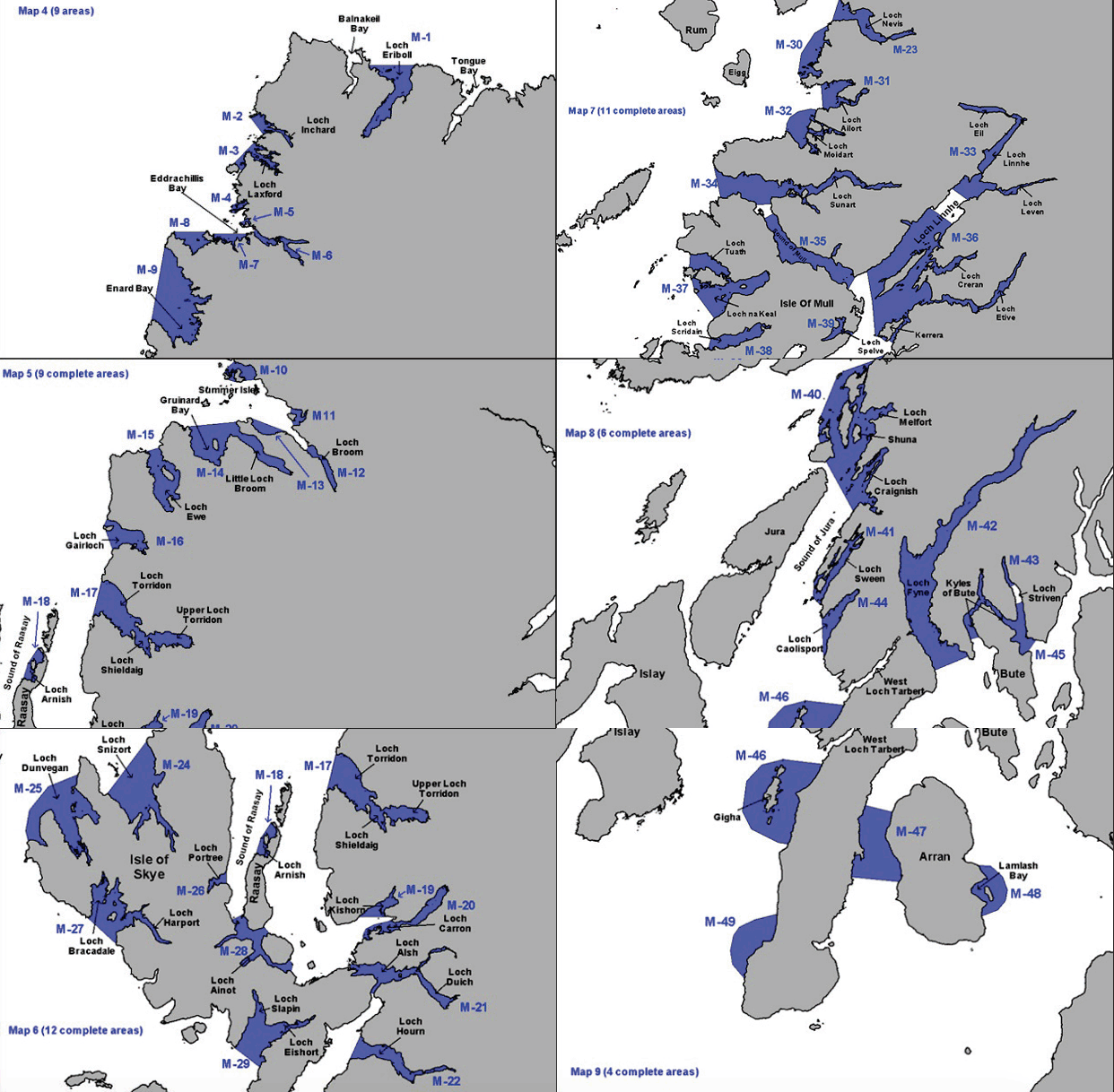
Figure 6: Mainland (49 management areas)
The nomenclature used in Figs. 3-6 is adopted for the rest of this report i.e. S1-S11 (Shetland, including S8a and S8b), O1-O4 (Orkney), M1-M49 (Mainland) and W1-W22 (Western Isles). GIS shape files (89 shape files), for the polygons giving the boundaries of these areas, have been provided through Marine Scotland Science (Fig. 8). Of these 89 areas, one represents a tiny extension of M13 (only 0.008km 2) and another is a westward extension of W14. Most of the FMAs are well-resolved in the combined shelf model mesh, however there are some that do not include any nodes of the model (M12, inner Loch Broom and M43, inner Loch Striven) and some that are only partially resolved ( e.g. S10 and M13). The FMAs numbered M11, M12 and M13 have therefore been combined within a boundary further out into the estuary and called LB (Loch Broom), see Fig. 9a. The inner FMA in Loch Striven (M43) has been extended south in order to enclose some model nodes (Fig. 9b). The resulting 86 polygons have been used to define the areas of sources and sinks for particle tracking.
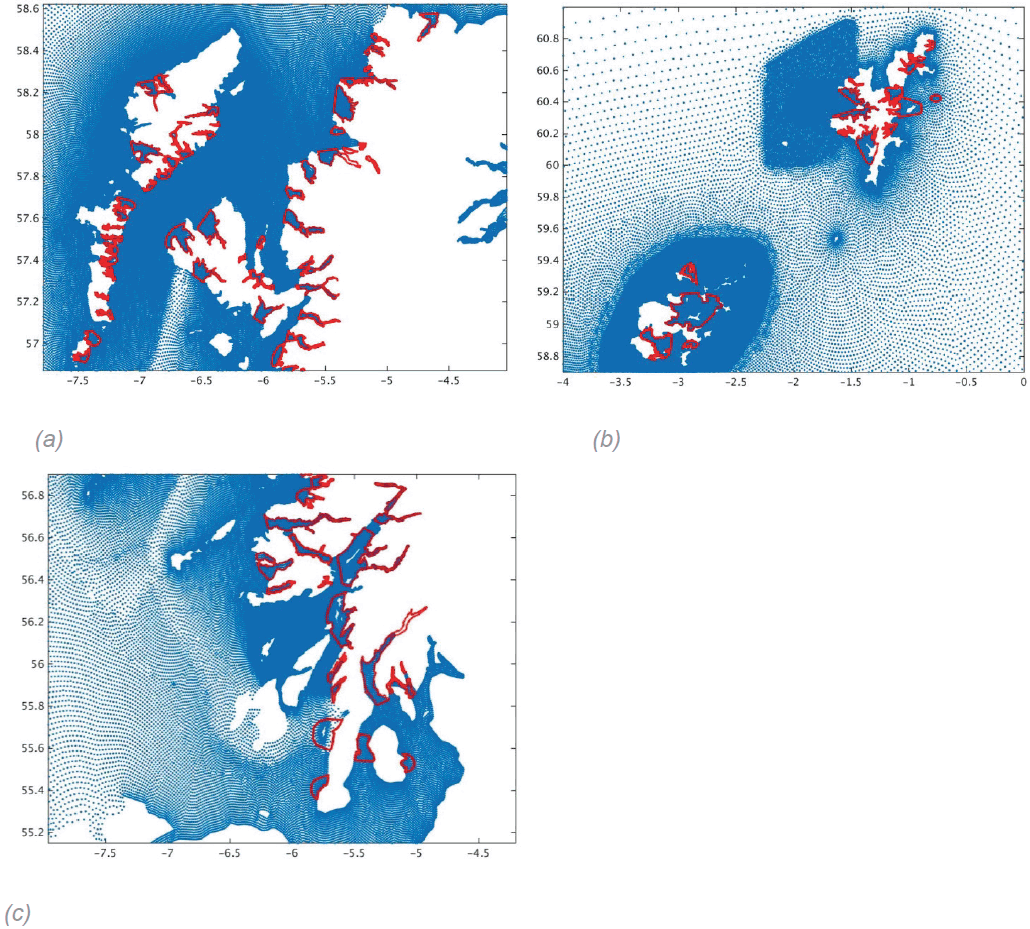
Figure 8: Plots of FMA shape files
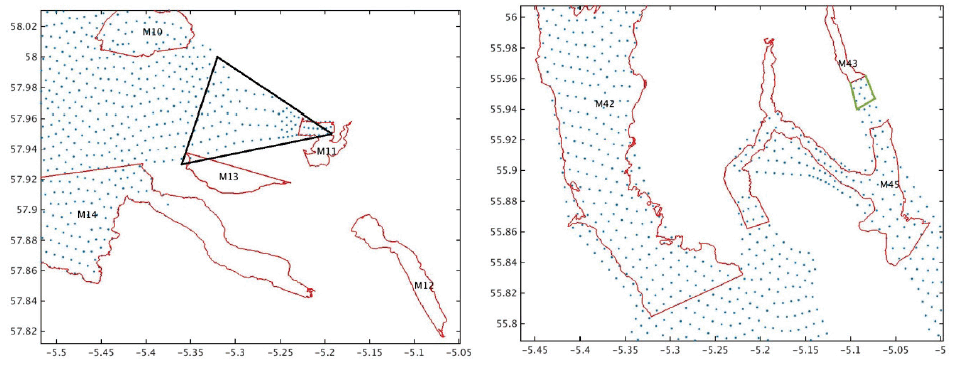
Figure 9: Modifications to FMA's (a) Loch Broom (left) (b) Loch Striven. Original FMA boundaries are in red, new boundaries in black; model nodes are blue dots
Various previous studies have been made of the hydrodynamic circulation, dispersion and particle tracking in the west of Scotland, related to sea lice dispersion. Dmitry Aleynik has built a Scottish West Coast FVCOM model, forced by a high-resolution WRF atmospheric model and shown excellent validation at high resolution in sea lochs (personal communication, UK FVCOM workshop, 2015). Other modelling work has validated the ability of high-resolution modelling to predict dispersion. For example Stashchuk et al. (2014) looked at horizontal dye dispersion in the Celtic Sea using a high resolution (50m), non-hydrostatic implementation of the MITgcm model, finding the dispersion is related to inertial oscillations and vertical shear. The most relevant work to this study is Adams et al. (2014a) which looked at larval dispersal of intertidal organisms in the Firth of Lorn on the west coast of Scotland, and found that meteorological variation and broad scale current patterns interact strongly with local geography to determine connectivity in coastal areas. They studied a range of larval durations (1-28 days), and two different meteorological forcing scenarios. They found that particles released from regions of high current velocity, open coastline and low local habitat availability travelled furthest but were less likely to disperse successfully to other coastal site. Adams et al. (2014b) considered whether renewable energy devices might act as stepping stones for the spread of intertidal marine organisms with pelagic larvae (such as barnacles), providing intermediate habitats, but this is not relevant to sea lice or virus transmission.
Murray and Gillibrand (2006) carried out particle tracking, using advection and turbulent diffusion for a structured grid model of Loch Torridon, forced by tides and winds. Inter-farm site exchange in Loch Torridon may occur under suitable winds. However, most lice remain in the basin that they are released in, even under these winds. Amundrud and Murray (2007; 2009) carried out further modelling of sea lice dispersal in Loch Torridon. They found that simulated dispersal patterns of viable sea lice demonstrate a high dependence on wind and freshwater forcing, such that validation must be carried out under a range of environmental conditions. The complex coastlines of Scottish fjords mean that wall parameterisations can have significant influence on individual particle tracks. In the first paper they examined the impact of varying wall parameterisations and found that a discrepancy in trajectories due to wall interactions will not greatly affect the dispersion pattern of a large number of particles. However, specific implementations of particle tracking models where diffusion is low, or not present, must consider the impact of wall interactions and experimental design should be robust enough to avoid allowing this feature to influence results. Another example of modelling of sea lice spread in Norway is given in Aldrin et al. (2013).
In the next section we introduce the FVCOM offline particle tracking model: this includes no biological behaviour, but particles can be released at different vertical levels and there are options for inclusion of a random walk diffusion term in the horizontal and vertical, as well as 3-dimensional advection. In section 3 we apply this using the SSM climatology-forced output (3D currents).
Contact
There is a problem
Thanks for your feedback